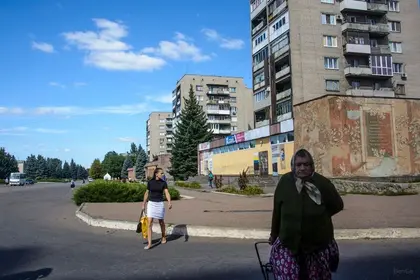The city is in a buffer zone between Ukrainian and Russian-backed separatist forces. Today‘s objective is to collect information from pro-Ukrainian sources in the city, while remainder of Ukrainian forces prepare for renewed hostilities.
In recent days, Ukrainian intelligence has received information about impending separatist assault – coinciding with Ukrainian Independence Day on Aug. 24, according to the head of Security Service of Ukraine Vasily Hrytsak. This may once again lead Donbas towards open hostilities.
JOIN US ON TELEGRAM
Follow our coverage of the war on the @Kyivpost_official.
Before the war, 12,000 people lived in Svitlodarsk; only a few thousand remain today. As with many other cities in Donbas, Svitlodarsk is strongly supportive of separatists. “Practically, there are no pro-Ukrainians here,” says Tarantino, one of St. Mary’s commanders who, like many in Ukraine’s military, refuse to be identified by their proper names.
The group visits the few pro-Ukrainian sources within the city, which provide the group with up to date information. “They understand the risk associated with working for us,” says Tarantino.
“Not a single person says hello, everyone stares angrily,” says a driver of the group. In the middle of the Sovet-built town centre, a faded Russian-flag is stenciled on the ground.

Residents enjoy the beach at a lake in front of the Vuhlehirska power station, a coal-fueled thermal power station.
In the main shops of the city, the most vital materials – such as dry foods and water – have been sold out. After two weeks of continuous artillery duels, three day silence seems odd. “I have worked in this city for a long time, but today I had a very bad feeling,” says Tarantino.
One of Svitlodarsk’s firefighters regularly visits Russian separatist-controlled Debaltseve, where second encirclement of Ukrainian forces took place during the Minsk II negotiations. “He’s from Debaltseeve, so he goes there often,” says one of the firefighters’ commander.
Tarantino walks away with the man to talk.
“He’s actually from Sloviansk” – one of the first cities to join the separatists, later retaken by Ukrainian forces in the summer of 2014.
“He told me that, in Debaltseve, there are no separatists forces or equipment. We know from our drone reconnaissance that there are currently large accumulated forces,” says Tarantino.
Ukrainian and separatist positions are clearly visible from the tall tower above the fire station. “From here, they guide separatist artillery against our forces; the station’s commander used to serve with an artillery unit,” says Tarantino.
St. Mary unit waves goodbye as they depart; the firefighters respond with the same. “This whole group are separatists,” swears one of the fighters.
Back in Artemivsk, 20 kilometers away from the front, the same mistrust between Ukrainian forces and local population exists.
Using information of Ukrainian intelligence and local units – such as St. Mary, an undisclosed number of separatists have been arrested.
“We arrest them, put them in local prison, and they get released the following day,” explains Tarantino. “In Artemivsk more than half of the police forces support separatists.”
The situation on the front line, north of Donetsk, remains tense. As from the start of Russia’s war in the Donbas, Russian propaganda continues to have deciding power, especially, here people remain reliant on Russian TV and radio as in Svitlodarsk.
Tarantino laughs: “The separatists have now started calling us Ukr-Wermacht.”
You can also highlight the text and press Ctrl + Enter




